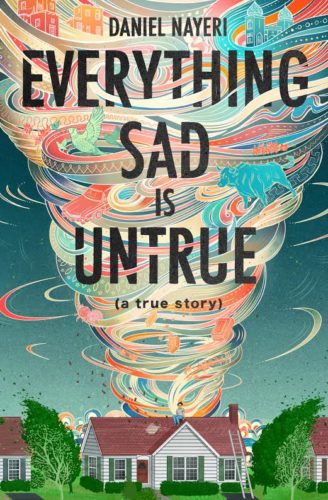On the spectrum of complicated tasks, analyzing the experience of your average middle schooler falls somewhere between quantum physics and putting together a loft bed from IKEA. At this age, kiddoes are growing physically, academically, and socially. And though it ends with a greater understanding of their personhood, the middle grades journey does not happen without obstacles.
In these three delicate and tumultuous years, heartbreak appears on the menu. Grandparents may be getting older. Relationships evolve and sometimes friendships diminish. As their teacher, you are expected to help them circumnavigate some tough issues. Thankfully literature provides both parties with a compass.
In this list, we’ve chosen books for middle schoolers that deal with serious and often painful issues. Our hope is that your kids read them, increase their empathy for other people, and understand that they are not alone in this problematic world.
Since reading comprehension hinges on relevant material and critical thinking, we’ve included classroom activities that help your students engage with each book.
The Hate U Give by Angie Thomas

Book Description: Starr Carter, at 16 years old, spends half her time at a prestigious preparatory school filled with privileged kids who don’t understand the trials other people face. The other part of Starr’s life takes place in a neighborhood devastated by poverty, a dichotomy that reveals how our country’s social and economic systems are designed to favor those who gain material wealth.
The narrative centers on Starr’s witness of her best friend’s death, a premature and tragic event. Only Starr knows the truth. Will she risk everything to bring the real story to light?
Why We Love It: Angie Thomas writes with candor about the trials and tribulations that people of color face. Even though the issues she writes about remain sadly relevant, her accessible language makes it easy for middle schoolers to grasp the importance of the books’ themes, issues, and ideas.
Classroom Activity: The book focuses on how speaking out is a difficult task. Ask your students to write about or discuss situations wherein they’d be called to break silence and tell the truth, even when the facts are uncomfortable for people with power.
Learn more about The Hate U Give.
Life As We Knew It by Susan Beth Pfeffer

Book Description: An asteroid hits the moon. The earth feels the repercussions in the form of one natural disaster after another. Tidal waves rise over cities; volcanoes spew white-hot magma; earthquakes make houses tremble; and the climate changes at a rapid pace.
Teenage protagonist Miranda has to navigate these abrupt and calamitous changes. Told in journal entries, the story chronicles how a young person feels after terrible, irreversible events happen. But throughout it all, Miranda holds on to hope.
Why We Love It: The book goes beyond traditional disaster narratives that focus on the spectacle. While the author doesn’t hold back from the damage inflicted, the crux of the book centers on Miranda’s feelings and thoughts. Your middle schoolers might not ever experience the kinds of natural disasters in this book, but the story does walk them through how to face the hardships of life’s changes.
Classroom Activity: Tie this book in with science lessons. Have your students get into groups and research the natural disasters that occur in the book. Their final project could be a presentation, a written report, or general classroom discussion.
Learn more about Life As We Knew It.
Free Lunch by Rex Ogle

Book Description: Rex Ogle’s nonfiction account follows the trials of an impoverished sixth grader who attends school in a wealthy district. He wears secondhand clothes, he feels embarrassed to be on a free lunch program, and he waits until all the other kids have left school so no one sees the hovel where he lives.
The story never shies away from the reality of what Rex faces. Furthermore, the author describes experiences that are unique to young people. In middle school, learning empathy is paramount; readers will gain insight into the tribulations that other people experience.
Why We Love It: Poverty is its own kind of pandemic. Children facing economic hardship have struggles at home that may impact their work in the classroom. The book sheds light on the reality of economic devastation, and highlights the experience of it for kids who are more fortunate.
Classroom Activity: Have your students research poverty in the U.S. Ask them to define poverty, show what causes it, and discuss ideas for how working families can enjoy the same opportunities as more privileged people.
Everything Sad Is Untrue by Daniel Nayeri

Book Description: When he tries to tell his classmates, no one believes Daniel’s story. Instead, they label him a dark-skinned boy with arms that are too hairy for his age. They think his lunch smells funny. They hate how he talks about weird stuff. Nevertheless, Daniel’s story is true and deserves to be heard.
Before arriving in town, Daniel and his family had to flee war-torn Iran in the middle of the night. The story oscillates between instances of bullying in real time and fantastic tales of Daniel’s ancestors.
Why We Love It: The United States is a nation of immigrants who bring a lovely diversity of culture, music, food, and history to our society. The classroom is perhaps the perfect embodiment of this reality. While that should make us feel fortunate, xenophobia, racism, and lack of understanding can sometimes muddy what should be a joyful learning experience.
Classroom Activity: The book features three stories from Daniel’s memory: “The Myth of the Baker and Tamar,” “The Legend of My Sister’s Cleverness,” and “The History of a Clown’s Underpants.” Divide your class into groups and have them re-read those meta-stories. Ask students to outline what happens in these stories and discuss their ideas about how and why the narrator shared them with his audience.
Learn more about Everything Sad Is Untrue.
Love Is a Revolution by Renée Watson

Book Description: This book follows Nala Robertson, a girl who falls in love with an activist who has interests that clash with her own. To impress him, she creates a new self-narrative built by untruths that become harder to keep up once the relationship progresses.
The story makes it clear: Everyone is worthy of love and deserving of joy. The author focuses on eschewing surface-level concerns in favor of a kind of self-love that stems from the kindness we show others.
Why We Love It: Self-love is a revolutionary act. The sooner kids believe that, and practice it, the happier and more productive they become. But our society often places unnecessary hurtles in front of young people, especially those who may not be petite, or have imperfect teeth, or feel that they aren’t as smart as their classmates.
Classroom Activity: Have your students write about self-love or do a small project. Ask them to define the concept and discuss how they can embark on the practice every day.
Learn more about Love Is a Revolution.
The Fault in Our Stars by John Green

Book Description: Many romance novels happen in a bustling city and include a beach scene punctuated by sunset. John Green’s most popular book takes place in a cancer ward—not exactly the traditional setting for a girl-meets-boy fairytale.
The book’s setting is not Green’s only unorthodox choice. The author focuses on how young people face insurmountable obstacles the same way adults do, but kids face a unique challenge in this regard. In the spry years of their life, when there are so many experiences and rites of passage they haven’t enjoyed, life-threatening illness aims to delete the joy they should be entitled to.
Why We Love It: While many dislike ambiguous endings, Green does a wonderful job of involving the reader in speculation. While assumptions are never a good idea, thoughtful musings on what could or should happen in an open-ended story are a great tool for the middle schooler’s developing mind.
Classroom Activity: LitLovers has compiled 13 thoughtful questions students can ponder as they read the novel. These queries can also serve as a guidepost for in-class discussions.






